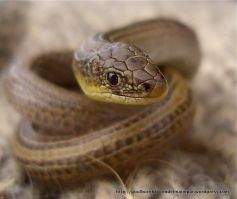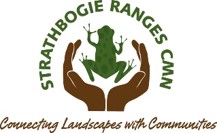
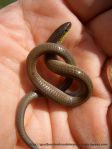 In the Goulburn Broken Catchment confusion is most likely between the Striped Legless Lizard (Delma impar) and the Olive Legless Lizard (D. inornata). The Olive Legless Lizard, growing to 35-40cm, is larger and more robust than the Striped Legless Lizard, but there is considerable overlap in size between the two species. For lizards, including legless lizards, body colouration is not always a good aid to species identification. The major cause of confusion is that Striped Legless Lizards don’t always have stripes; many individuals are a pale brown/tan colour, similar to the Olive legless Lizard.
In the Goulburn Broken Catchment confusion is most likely between the Striped Legless Lizard (Delma impar) and the Olive Legless Lizard (D. inornata). The Olive Legless Lizard, growing to 35-40cm, is larger and more robust than the Striped Legless Lizard, but there is considerable overlap in size between the two species. For lizards, including legless lizards, body colouration is not always a good aid to species identification. The major cause of confusion is that Striped Legless Lizards don’t always have stripes; many individuals are a pale brown/tan colour, similar to the Olive legless Lizard.
The Olive Legless Lizard has similar body colouration to the Striped Legless Lizard, but completely lacks stripes. It lacks the often bright yellow face/cheeks of the Striped, but has a more distinct white eye-ring.
There are several characters that help to separate the two species. The most reliable is the presence/absence of a suture anterior to the nostril. Its presence in the Olive Legless Lizard separates the nasal scale from the 1st supra-labial scale. In the Striped Legless Lizard, these two scales are fused. See diagrams and images below.
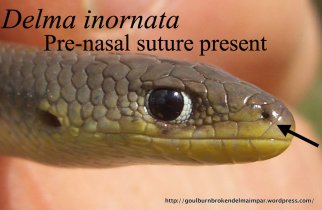


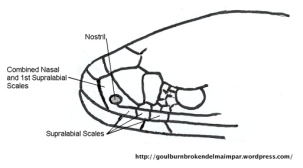
Olive Legless Lizard – with suture Striped Legless Lizard – without suture
As the presence/absence of this character (suture) can only clearly be seen with magnification and may be indistinct in field specimens, often due to pigmentation and the proximity of the nostril to the supralabial/nasal scale, use of other characteristics may aid identification of specimens.
Another difference between Olive and Striped Legless Lizards is the number of scales on the head/snout. Cogger, in Reptiles and Amphibians of Australia (2014), describes this difference as ‘five scales on top of snout between rostral and frontal shields’ for D. impar and ‘usually seven, but occasionally five scales on top of snout between rostral and frontal shields.’ Robertson and Coventry, in Reptiles of Victoria (2019) describe D. inornata as having ‘two posterior nasal scales that usually do not contact the nostrils.’
My interpretation of this distinction is shown in the illustration below.
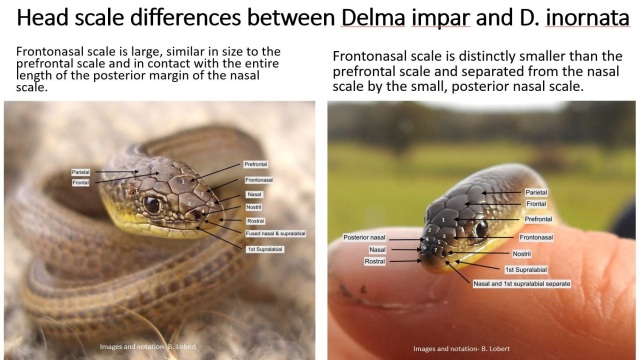
In any case, confusion only occurs with individuals lacking distinct stripes; and evidence of stripes, even if faint, mark a specimen as a Striped Legless Lizard. Where specimens lack stripes and it’s not possible to determine whether the pre-nasal suture is present, snout scales can be used to distinguish between the species. Without a hand-held specimen, or if a photographic image showing these characters isn’t available, the following characters can aid identification:
- Is the snout-vent length greater than 120 mm? If yes … likely to be the Olive Legless Lizard.
- Is the total length greater than 30 cm? If yes … most likely to be the Olive Legless Lizard.
- Does the animal have strong yellow colouration behind the eyes and extending back to the ears? If yes … likely to be the Striped Legless Lizard.
- Is the ring of scales around the eyes a bright white colour, rather than a pale cream colour? If yes … likely to be the Olive Legless Lizard.
Images of Striped Legless Lizards from the Upper Goulburn.
Images of Olive Legless Lizards from northern and north-east Victoria.


